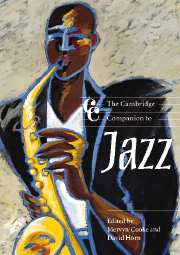Book contents
- Frontmatter
- The word jazz
- Part One Jazz times
- Part Two Jazz practices
- 5 Jazz as musical practice
- 6 Jazz as cultural practice
- 7 Jazz improvisation
- 8 Spontaneity and organisation
- 9 Jazz among the classics, and the case of Duke Ellington
- Part Three Jazz changes
- Part Four Jazz soundings
- Part Five Jazz takes
- Notes
- Works cited
- Principal musicians cited
- Index
7 - Jazz improvisation
from Part Two - Jazz practices
Published online by Cambridge University Press: 28 September 2011
- Frontmatter
- The word jazz
- Part One Jazz times
- Part Two Jazz practices
- 5 Jazz as musical practice
- 6 Jazz as cultural practice
- 7 Jazz improvisation
- 8 Spontaneity and organisation
- 9 Jazz among the classics, and the case of Duke Ellington
- Part Three Jazz changes
- Part Four Jazz soundings
- Part Five Jazz takes
- Notes
- Works cited
- Principal musicians cited
- Index
Summary
The goal of this chapter is to provide an overview of the principal musical resources used in jazz improvisation as well as an approach to listening to jazz from the ‘bottom up’ – a way of hearing that will stress the interactive interplay between the soloist and the accompaniment. The melodic vocabulary of the improvising jazz soloist, which is what generally first catches the new listener's attention, must always be seen as emerging in a complex dialogue between the soloist and the rhythm section, and between the preexisting musical knowledge of the band members and what they collectively discover in the process of improvisation.
Among the many musical characteristics associated with jazz are improvisation, syncopation, swing, blues feeling, call-and-response organisation and harmonic complexity. Improvisation and swing are often considered to be the most important elements of jazz, although defining them has proved elusive. Improvisation has been described as the spontaneous creation of music in performance, but the sense of improvisation as elaborating upon something previously known is sometimes lost in this definition. Swing has generally been defined as forward propulsion through time resulting from the interplay between a fixed underlying pulse and the unevenly articulated subdivisions of that pulse which must ultimately be shaped into convincing phrases. The improviser does this in call-and-response with a rhythm section (generally piano or guitar, bass and drums) – an ensemble within an ensemble whose function is both to keep time and interact with the soloist.
- Type
- Chapter
- Information
- The Cambridge Companion to Jazz , pp. 114 - 132Publisher: Cambridge University PressPrint publication year: 2003
- 3
- Cited by



